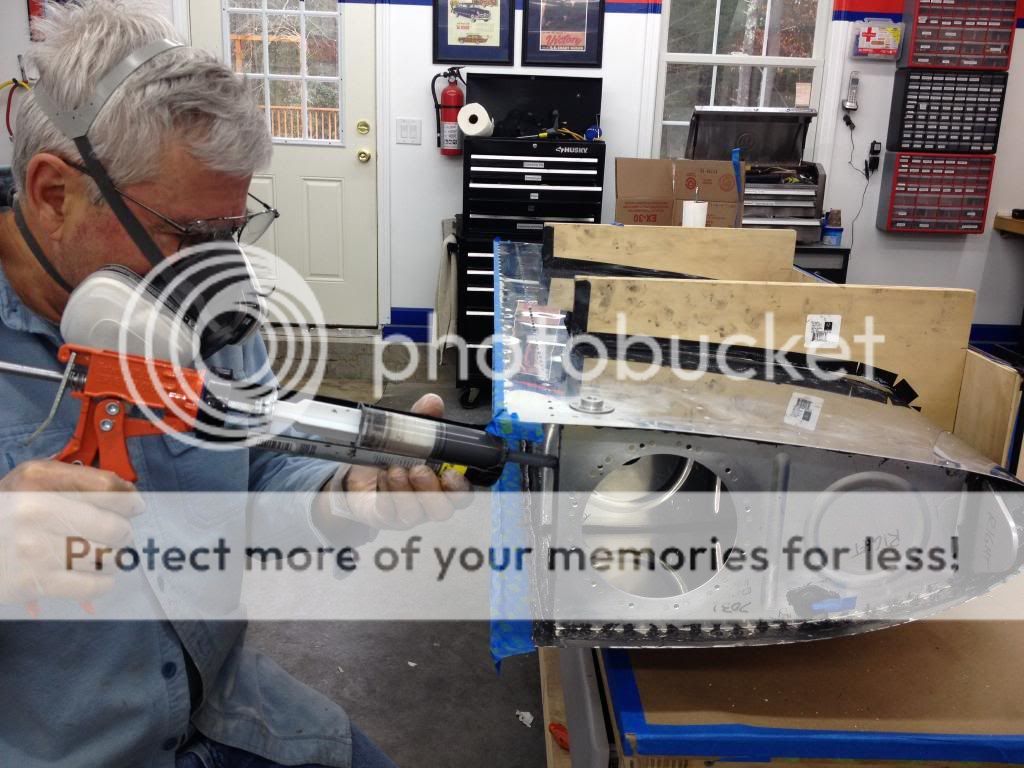I am closing in on sealing my tanks in the next couple of weeks and wanted to ask a few questions.
-Vans has sealant in their web store, but it isn't "ProSeal". AC Spruce has Proseal, albeit at about double the cost for the same quantity. I am leaning towards the VANS stuff because that is what the book says, but should I be getting actual Proseal from Spruce instead?
-In my Vans shopping cart, I have the pre-fab'd fuel pickup (with screen), the test kit, the "regular" old float type sending units, and (for now) the sealant.
...Is there anything else I am missing?
...Do I need bushings for the vent line, or do they come in the RV-7 kit?
...I've seen mention of a "sealed" or closed nutplate for the retaining ring / access plate. Are these needed, or can I stick with the regular old nutplates.
-The T-410 Nose Reinforcement plate, should I position that so that it matches the rib contour, or should I move it further forward and butt it up against the skin?
I've read the very awesome post from Rick re: how he seals up his tanks. I'm thinking I'll get the stiffeners, fuel cap, and drain done in one session (i.e. seal and rivet at the same time). For the ribs, I was going to coat them with sealant and install all of them with cleco's in every hole. Once all of them were cleco'd in, I was going to swing back around and rivet them rather then waiting 2-3 days. I've read about concerns that the cleco's don't squeeze out enough and to not wait, so I figured I'd cleco them all in and rivet the same day.
At this point I think we will have run out of daylight (figuratively speaking). Is it ok to run a bead along each rib and then hit the shop heads with sealant the next day or a few days after riveting the ribs in? Also, the baffle will probably have to wait until the next weekend. Any issues with that?
Does anyone see any issues with any of the above? I think I thought it through enough, but there is a lot of experience here that I'd like to tap into before I jump.
John
Houston, TX
RV-7A
Empennage (Mostly Done)
Wing (Tanks)
-Vans has sealant in their web store, but it isn't "ProSeal". AC Spruce has Proseal, albeit at about double the cost for the same quantity. I am leaning towards the VANS stuff because that is what the book says, but should I be getting actual Proseal from Spruce instead?
-In my Vans shopping cart, I have the pre-fab'd fuel pickup (with screen), the test kit, the "regular" old float type sending units, and (for now) the sealant.
...Is there anything else I am missing?
...Do I need bushings for the vent line, or do they come in the RV-7 kit?
...I've seen mention of a "sealed" or closed nutplate for the retaining ring / access plate. Are these needed, or can I stick with the regular old nutplates.
-The T-410 Nose Reinforcement plate, should I position that so that it matches the rib contour, or should I move it further forward and butt it up against the skin?
I've read the very awesome post from Rick re: how he seals up his tanks. I'm thinking I'll get the stiffeners, fuel cap, and drain done in one session (i.e. seal and rivet at the same time). For the ribs, I was going to coat them with sealant and install all of them with cleco's in every hole. Once all of them were cleco'd in, I was going to swing back around and rivet them rather then waiting 2-3 days. I've read about concerns that the cleco's don't squeeze out enough and to not wait, so I figured I'd cleco them all in and rivet the same day.
At this point I think we will have run out of daylight (figuratively speaking). Is it ok to run a bead along each rib and then hit the shop heads with sealant the next day or a few days after riveting the ribs in? Also, the baffle will probably have to wait until the next weekend. Any issues with that?
Does anyone see any issues with any of the above? I think I thought it through enough, but there is a lot of experience here that I'd like to tap into before I jump.
John
Houston, TX
RV-7A
Empennage (Mostly Done)
Wing (Tanks)





